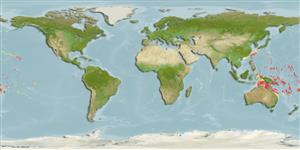Classification / Names
Nombres comunes | Sinónimos | Catalog of Fishes(Género, Especie) | ITIS | CoL | WoRMS | Cloffa
>
Eupercaria/misc (Various families in series Eupercaria) >
Labridae (Wrasses) > Bodianinae
Etymology: Bodianus: Bodianus after Bodiano or Pudiano, from the Portuguese pudor, meaning modesty (Jordan & Evermann, 1896).; paraleucosticticus: Name from the Greek 'para' for near, 'leukos' for white, and 'stiktos' for spotted, referring to the close relationship between this species and B. leucosticticus..
Environment: milieu / climate zone / depth range / distribution range
Ecología
marino asociado a arrecife; rango de profundidad 50 - 115 m (Ref. 75973). Tropical
Western Pacific: Rarotonga and Papua New Guinea; and a photo taken in New Caledonia.
Tamaño / Peso / Age
Maturity: Lm ? range ? - ? cm
Max length : 9.9 cm SL macho / no sexado; (Ref. 75973)
Short description
Claves de identificación | Morfología | Morfometría
Espinas dorsales (total) : 12; Radios blandos dorsales (total) : 10; Espinas anales: 3; Radios blandos anales: 12. This species is distinguished by the following characters: predorsal scales 18-19, reaching forward barely beyond above center of eye on dorsal midline of head; total gill rakers 15-17; dorsal fin with long spines, the first spine 7.8-8.1% SL, second spine 9.5-10.3% SL, and 12th spine 15.0-16.7% SL; anal fin's first spine 6.6-8.8% SL and third spine 15.1-17.7% SL; short maximum body length (longest specimen known 100 mm SL); sides of body with 4 narrow red stripes becoming yellow posteriorly and fifth stripe ventrally yellow; prominent black spot on fleshy pectoral-fin base; prominent black spot covering most of anterior end of dorsal fin between first and fourth spines (Ref. 75973).
Oviparous, distinct pairing during breeding (Ref. 205).
Life cycle and mating behavior
Maturities | Reproducción | Spawnings | Egg(s) | Fecundities | Larva
Oviparous, distinct pairing during breeding (Ref. 205).
Gomon, M.F., 2006. A revision of the labrid fish genus Bodianus with descriptions of eight new species. Rec. Aust. Mus. Suppl. 30:1-133. (Ref. 75973)
IUCN Red List Status (Ref. 130435)
Threat to humans
Harmless
Human uses
Herramientas
Special reports
Download XML
Fuentes de Internet
Estimates based on models
Preferred temperature (Ref.
123201): 23.1 - 29, mean 26.3 °C (based on 14 cells).
Phylogenetic diversity index (Ref.
82804): PD
50 = 0.5000 [Uniqueness, from 0.5 = low to 2.0 = high].
Bayesian length-weight: a=0.01202 (0.00551 - 0.02625), b=3.05 (2.87 - 3.23), in cm total length, based on LWR estimates for this Genus-body shape (Ref.
93245).
Nivel trófico (Ref.
69278): 3.3 ±0.5 se; based on size and trophs of closest relatives
Resiliencia (Ref.
120179): Alto, población duplicada en un tiempo mínimo inferior a 15 meses (Preliminary K or Fecundity.).
Fishing Vulnerability (Ref.
59153): Low vulnerability (10 of 100).
